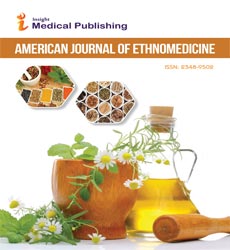ISSN : 2348-9502
American Journal of Ethnomedicine
Ethnomedicinal Plants in the Treatment of Diabetes Mellitus: A Review
Fatemeh Goyal
Department of Natural Medicine, University of Toyama, 2630 Sugitani, Toyama 930-0194, Japan
Corresponding author:
Fatemeh Goyal,
Department of Natural Medicine, University of Toyama, 2630 Sugitani, Toyama 930-0194, Japan;
Email: fatemeh@goyal.jp
Received date: February 01, 2025, Manuscript No. Ipaje-25-20599; Editor assigned date: February 03, 2025, PreQC No. Ipaje-25-20599(PQ); Reviewed date: February 15, 2025, QC No. Ipaje-25-20599; Revised date: February 22, 2025, Manuscript No. Ipaje-25-20599(R); Published date: February 28, 2025, DOI: 10.36648/ 2471-7975.12.1.104
Citation: Goyal F (2025) Ethnomedicinal Plants in the Treatment of Diabetes Mellitus: A Review. Am J Ethnomed Vol.12 No.1:104
Introduction
Ethnomedicinal plants have long been used across cultures to manage diabetes mellitus, offering a rich pharmacopeia of botanicals that exert hypoglycemic effects through diverse mechanisms; renewed scientific interest aims to validate traditional knowledge, identify bioactive compounds, and integrate safe, evidence-based plant therapies into modern diabetes care while addressing concerns of standardization, efficacy, and safety [1].
Description
Many plant-derived remedies act through insulinotropic or insulin-sensitizing mechanisms: for example, gymnemic acids from Gymnema sylvestre and compounds in Momordica charantia (bitter melon) have been reported to stimulate insulin secretion, regenerate or protect pancreatic β-cells, and improve glucose uptake in peripheral tissues; fenugreek (Trigonella foenum-graecum) seeds contain soluble fibers and 4- hydroxyisoleucine which slow carbohydrate absorption and enhance insulin release, while cinnamon (Cinnamomum spp.) polyphenols appear to potentiate insulin signaling and glucose uptake. Other plants work by inhibiting carbohydrate-digesting enzymesâ??reducing postprandial hyperglycemiaâ??such as various flavonoid-rich extracts that show α-glucosidase and α- amylase inhibition; berberine (from Berberis spp.) and related alkaloids modulate AMPK pathways, improving insulin sensitivity and lipid metabolism, which is particularly important in metabolic syndrome and type 2 diabetes contexts. Beyond direct glucose-lowering actions, many ethnomedicinal plants confer ancillary benefits relevant to diabetes management: antioxidant and anti-inflammatory phytochemicals (polyphenols, flavonoids, terpenoids) Reduce oxidative stress and chronic inflammation that drive β- cell dysfunction and diabetic complications; lipid-lowering and antihypertensive effects. Reported for herbs like garlic (Allium sativum), Aloe vera, and Tinospora cordifolia can improve cardiometabolic risk profiles; and certain bioactive constituents have been formulated into nanoparticle carriers or combined with conventional drugs to enhance bioavailability and therapeutic index in preclinical studies. Nevertheless, clinical evidence is heterogeneousâ??some randomized trials and meta-analyses suggest modest glycemic benefits for agents such as berberine, cinnamon, and fenugreek, but methodological limitations (small sample sizes, short durations, variable extracts/doses) and mixed outcomes mean that robust, large-scale RCTs with standardized preparations are still needed to confirm long-term efficacy and safety [2]. Practical and regulatory challenges limit translation: phytochemical variability due to species, growing conditions, harvest time, and extraction methods causes inconsistent potency; dose standardization, quality control (contaminants, adulteration), and clear pharmacokinetic profiles are often lacking; herbâ??drug interactions (e.g., additive hypoglycemia when combined with insulin or oral hypoglycemics, or interactions via CYP enzymes and P-glycoprotein) pose real clinical risks, especially in polypharmacy common among diabetic patients. Safety concerns include idiosyncratic toxicity, heavy-metal contamination in some herbal products, and reproductive or developmental risks that are underreported. To responsibly integrate ethnomedicinal plants into diabetes care, clinicians and researchers must prioritize rigorous standardization, phytochemical characterization, dose-finding studies, mechanistic investigations, and long-term outcome trials, while educating patients to disclose herbal use and monitoring for interactions and adverse effects [3,5].
Conclusion
In summary, ethnomedicinal plants offer multiple promising biochemical pathways and complementary benefits for diabetes managementâ??ranging from insulin secretion and sensitization to antioxidant and cardiometabolic effectsâ??but current evidence is mixed and hampered by standardization and safety gaps; moving forward requires high-quality clinical trials, standardized extracts, clear regulatory frameworks, and integrated models that combine traditional knowledge with modern pharmacology to determine which plant-based therapies can safely and effectively augment conventional. Furthermore, interdisciplinary collaboration between ethnobotanists, pharmacologists, clinicians, and policymakers will be essential to bridge the gap between traditional practices and scientific validation, ensuring that therapeutic potentials are fully explored without compromising safety or efficacy. Developing robust phytochemical profiling techniques and biomarker-based monitoring systems can help identify active compounds, optimize dosage regimens, and reduce variability across studies.
References
- Mazurek M, Szewc M, Sitarz MZ, DudziÅ?ska E, Sitarz R (2024) Gastric Cancer: An Up-to-Date Review With New Insights Into Early-Onset Gastric Cancer. Cancers 16: 3163
Google Scholar Cross Ref Indexed at
- Ren J, Jin X, Li J, Li R, Gao Y, et al. (2022) The Global Burden of Peptic Ulcer Disease in 204 Countries and Territories From 1990 to 2019: A Systematic Analysis for the Global Burden of Disease Study 2019. Int J Epidemiol 51: 1666-1676
Google Scholar Cross Ref Indexed at
- Wang R, Li Z, Liu S, Zhang D (2023) Global, Regional and National Burden of Inflammatory Bowel Disease in 204 Countries and Territories From 1990 to 2019: A Systematic Analysis Based on the Global Burden of Disease Study 2019. BMJ Open 13: e065186
Google Scholar Cross Ref Indexed at
- Kipkore W, Wanjohi B, Rono H, Kigen G (2014) A Study of the Medicinal Plants Used by the Marakwet Community in Kenya. J Ethnobiol Ethnomed 10: 24
Google Scholar Cross Ref Indexed at
- Farrag ARH, Abdallah HM, Khattab AR, Elshamy AI, El Gendy AENG, et al. (2019) Antiulcer Activity of Cyperus alternifolius in Relation to Its UPLC-MS Metabolite Fingerprint: A Mechanistic Study. Phytomedicine 62: 152970
Open Access Journals
- Aquaculture & Veterinary Science
- Chemistry & Chemical Sciences
- Clinical Sciences
- Engineering
- General Science
- Genetics & Molecular Biology
- Health Care & Nursing
- Immunology & Microbiology
- Materials Science
- Mathematics & Physics
- Medical Sciences
- Neurology & Psychiatry
- Oncology & Cancer Science
- Pharmaceutical Sciences
